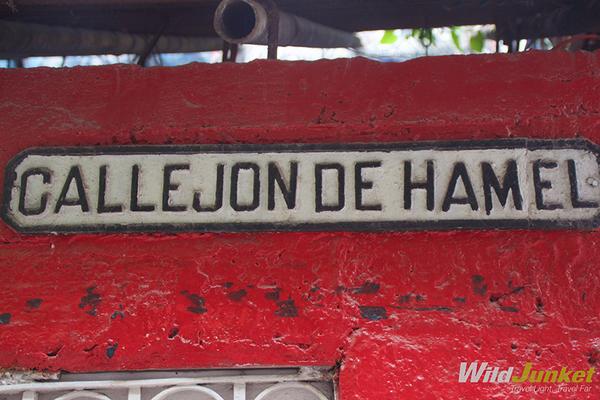Loud, rhythmic chants and drum beats echo through the alley flanked by funky street murals and edgy art installations. The beats are fast and fierce, and they grow louder and faster along with the chants. The young rumba dancer picks up his pace as well, knees jerking and hips gyrating to the soulful music. The singers are chanting in a language I can’t quite recognize, but it adds to the flair of this music ensemble.

Callejon de Hamel.
For the uninitiated, rumba is a secular genre of Cuban music involving dance, percussion and song. It’s frenetic and full of energy, powerful yet hypnotizing at the same time. The music bears strong hints of its West African roots, with percussion music weaved into up-tempo rhythms.
During the 19th century in Cuba, rumba was traditionally performed by poor workers of African descent on the streets and in solares (courtyards) using cajones (wooden boxes) that were eventually replaced by tumbadoras (conga drums). Today, rumba remains one of Cuba's most characteristic forms of music and dance.

Rumba players.
Here in the Callejon de Hamel, rumba is a way of life. The Afro-Cubans live and breathe rumba, and it’s an important part of their cultural identity. There’s no better place to get a feel for it than here at this eclectic corner of Havana. The rumba performance kicks off every Sunday around noon, and draws in quite a crowd.
Quirky Afro-Cuban art
Located off Lazaro Street in Centro Habana, the callejon, or small alley, may be just a few blocks from the seafront Malecón Boulevard, but it’s very different from anything I’ve seen in Havana.

An open air museum.
Dedicated to Afro-Cuban art and culture, the Callejon de Hamel is an alleyway packed with psychedelic art installations, quirky bars, Santeria figures and sculptures. The buildings feature large murals painted in vivid colours, hand-carved wooden Orisha statues and scrap objects that have been transformed into artwork.
Most of the artwork on display at Callejon de Hamel is created by Salvador Gonzáles Escalona, a painter, muralist and sculptor from Camagüey in Central Cuba. He describes his Afro-Cuban work as a mix of surrealism, cubism and abstract art.

Psychedelic mural paintings.
In 1990, he set up his art gallery here in Callejon de Hamel, which sparked a major transition in this otherwise impoverished district. Despite a challenging start, he was inspired by local inhabitants to continue his work, and, eventually, the street was transformed from a slum area to an Afro-Cuban cultural centre.
Today Callejon de Hamel is akin to an open-air museum for thriving artists. There are workshops for young Cuban children to learn painting, and shops where artwork is on sale for visitors to bring home as souvenir.
Tracing the roots of Santeria traditions
Aside from the rumba performances and artwork, Callejon de Hamel is also home to Santeria temples and larger-than-life statues of Orishas (Santeria spirits).
Santeria is a syncretic religion that has its roots in West Africa. Most of the ancestors of today’s Afro-Cubans were forcibly brought from West Africa to Cuba to be enslaved peoples. Although most Africans were forced to convert to Catholicism by their masters, they pretended they were practicing Christianity by praying to the saints, while remaining faithful to their animistic beliefs.
Practitioners of Santeria, also known as Regla de Ocha, might describe themselves as Catholic and attend Catholic masses, while practicing their African-based religion in their temple-house or in the home of a religious elder. They find similarities between the Catholic saints and their own saints; for instance, Saint Barbara or the Virgin of Charity is a manifestation of Changó, one of the most popular Orishas in Cuba.

A Santeria Orisha statue.
For centuries, Santeria was practiced as a somewhat "secret" religion as a way to avoid religious persecution or the negative social stigma attached to Afro-Cuban culture in general. It survived as an oral tradition, passed down from one generation to another through initiation ceremonies that created a tightly bound community and distinct lineages based on ancestors.
Today, the Afro-Cubans are free to practice Santeria and their temples and Orisha statues can be seen at the Callejon de Hamel. Many of them have been created using scrap objects, another example of how art is incorporated into their religion.
It’s easy to see why Callejon de Hamel draws in so many travellers — it’s unique and unlike anything else in Havana. Some people argue that it’s lost its charm because of the crowds, but don’t believe them, this is still one of the most interesting spots in Havana to visit.
Getting There
G Adventures runs a number of departures in Cuba encompassing a wide range of departure dates and activities to cater to different tastes. We’re thrilled at the prospect of showing you this big blue planet of ours — check out our small group trips here.























